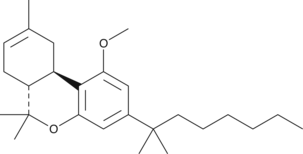Chemicals
Showing 24301–24450 of 41137 results
-
The lipid mediator thromboxane (TX)A2 plays a key role in platelet aggregation and vascular and bronchial smooth muscle constriction. The actions of TXA2 are mediated by its specific G protein-coupled receptor, referred to as the TXA2 receptor or TP. Two isoforms, TPα and TPβ, are produced from a single gene, differ in their carboxyl termini, and form homo- and hetero-oligomers.{14489} While both isoforms signal through similar pathways, they differ in the modulation by certain agonists.{17467} L-655,240 is a potent antagonist of the TP receptor in vitro (IC50 = 7 nM).{17468,1099} It also is effective at blocking TP-mediated bronchoconstriction in vivo and platelet aggregation ex vivo.{17468} Whether the two TP isoforms differ in their sensitivity to L-655,240 is not known.
Brand:CaymanSKU:10011562 - 25 mgAvailable on backorder
The lipid mediator thromboxane (TX)A2 plays a key role in platelet aggregation and vascular and bronchial smooth muscle constriction. The actions of TXA2 are mediated by its specific G protein-coupled receptor, referred to as the TXA2 receptor or TP. Two isoforms, TPα and TPβ, are produced from a single gene, differ in their carboxyl termini, and form homo- and hetero-oligomers.{14489} While both isoforms signal through similar pathways, they differ in the modulation by certain agonists.{17467} L-655,240 is a potent antagonist of the TP receptor in vitro (IC50 = 7 nM).{17468,1099} It also is effective at blocking TP-mediated bronchoconstriction in vivo and platelet aggregation ex vivo.{17468} Whether the two TP isoforms differ in their sensitivity to L-655,240 is not known.
Brand:CaymanSKU:10011562 - 5 mgAvailable on backorder
L-655,708 is a ligand for α5 subunit-containing GABAA receptors that has nootropic activity.{56024} It selectively binds to α5 subunit-containing GABAA receptors over α1, α2, or α3 subunit-containing receptors (Kis = 1, 70, 48, and 31 nM, respectively, for recombinant human receptors). L-655,708 (10 nM) increases the amplitude of extracellular post-synaptic potentials (EPSPs) in mouse hippocampal slices. In vivo, L-655,708 (1.5 mg/animal) decreases the latency to find the platform and increases time spent in the target quadrant in the Morris water maze in mice.
Brand:CaymanSKU:30322 - 10 mgAvailable on backorder
L-655,708 is a ligand for α5 subunit-containing GABAA receptors that has nootropic activity.{56024} It selectively binds to α5 subunit-containing GABAA receptors over α1, α2, or α3 subunit-containing receptors (Kis = 1, 70, 48, and 31 nM, respectively, for recombinant human receptors). L-655,708 (10 nM) increases the amplitude of extracellular post-synaptic potentials (EPSPs) in mouse hippocampal slices. In vivo, L-655,708 (1.5 mg/animal) decreases the latency to find the platform and increases time spent in the target quadrant in the Morris water maze in mice.
Brand:CaymanSKU:30322 - 25 mgAvailable on backorder
L-655,708 is a ligand for α5 subunit-containing GABAA receptors that has nootropic activity.{56024} It selectively binds to α5 subunit-containing GABAA receptors over α1, α2, or α3 subunit-containing receptors (Kis = 1, 70, 48, and 31 nM, respectively, for recombinant human receptors). L-655,708 (10 nM) increases the amplitude of extracellular post-synaptic potentials (EPSPs) in mouse hippocampal slices. In vivo, L-655,708 (1.5 mg/animal) decreases the latency to find the platform and increases time spent in the target quadrant in the Morris water maze in mice.
Brand:CaymanSKU:30322 - 5 mgAvailable on backorder
L-655,708 is a ligand for α5 subunit-containing GABAA receptors that has nootropic activity.{56024} It selectively binds to α5 subunit-containing GABAA receptors over α1, α2, or α3 subunit-containing receptors (Kis = 1, 70, 48, and 31 nM, respectively, for recombinant human receptors). L-655,708 (10 nM) increases the amplitude of extracellular post-synaptic potentials (EPSPs) in mouse hippocampal slices. In vivo, L-655,708 (1.5 mg/animal) decreases the latency to find the platform and increases time spent in the target quadrant in the Morris water maze in mice.
Brand:CaymanSKU:30322 - 50 mgAvailable on backorder
L-685,458 is an inhibitor of γ-secretase (IC50 = 17 nM).{10285} It is selective for γ-secretase over HIV-1, cathepsin D, trypsin, HepC3 NS3, papain, and calpain I proteases (IC50s = >1,000 nM). L-685,458 inhibits production of amyloid-β (1-40) (Aβ40; Item No. 21617) and Aβ42 (Item No. 20574) in Neuro2A cells transfected with human amyloid precursor protein (APP; IC50s = 402 and 775 nM, respectively). It is also an inhibitor of Notch signaling that blocks hypoxia-induced activity of the Notch-responsive reporters 12xCSL and CBF1 in isolated rat intervertebral disc cells.{35885}
Brand:CaymanSKU:-L-685,458 is an inhibitor of γ-secretase (IC50 = 17 nM).{10285} It is selective for γ-secretase over HIV-1, cathepsin D, trypsin, HepC3 NS3, papain, and calpain I proteases (IC50s = >1,000 nM). L-685,458 inhibits production of amyloid-β (1-40) (Aβ40; Item No. 21617) and Aβ42 (Item No. 20574) in Neuro2A cells transfected with human amyloid precursor protein (APP; IC50s = 402 and 775 nM, respectively). It is also an inhibitor of Notch signaling that blocks hypoxia-induced activity of the Notch-responsive reporters 12xCSL and CBF1 in isolated rat intervertebral disc cells.{35885}
Brand:CaymanSKU:-L-685,458 is an inhibitor of γ-secretase (IC50 = 17 nM).{10285} It is selective for γ-secretase over HIV-1, cathepsin D, trypsin, HepC3 NS3, papain, and calpain I proteases (IC50s = >1,000 nM). L-685,458 inhibits production of amyloid-β (1-40) (Aβ40; Item No. 21617) and Aβ42 (Item No. 20574) in Neuro2A cells transfected with human amyloid precursor protein (APP; IC50s = 402 and 775 nM, respectively). It is also an inhibitor of Notch signaling that blocks hypoxia-induced activity of the Notch-responsive reporters 12xCSL and CBF1 in isolated rat intervertebral disc cells.{35885}
Brand:CaymanSKU:-L-701,324 is an NMDA receptor antagonist.{57099} It inhibits NMDA-induced currents in rat cortical neurons (Ki = 5.4 nM). L-701,324 inhibits seizures induced by N-methyl-DL-aspartate, pentylenetetrazole (PTZ; Item No. 18682), or electroshock, as well as audiogenic seizures in mice (ED50s = 3.5, 2.8, 1.4, and 0.96 mg/kg, respectively).{57100} It reduces the number of audiogenic seizures in a rat model of ethanol-induced withdrawal seizures when administered at a dose of 5 mg/kg.{57101} L-701,324 (2.5 and 5 mg/kg) reduces amphetamine-induced hyperactivity in rats.{57102}
Brand:CaymanSKU:30687 - 10 mgAvailable on backorder
L-701,324 is an NMDA receptor antagonist.{57099} It inhibits NMDA-induced currents in rat cortical neurons (Ki = 5.4 nM). L-701,324 inhibits seizures induced by N-methyl-DL-aspartate, pentylenetetrazole (PTZ; Item No. 18682), or electroshock, as well as audiogenic seizures in mice (ED50s = 3.5, 2.8, 1.4, and 0.96 mg/kg, respectively).{57100} It reduces the number of audiogenic seizures in a rat model of ethanol-induced withdrawal seizures when administered at a dose of 5 mg/kg.{57101} L-701,324 (2.5 and 5 mg/kg) reduces amphetamine-induced hyperactivity in rats.{57102}
Brand:CaymanSKU:30687 - 100 mgAvailable on backorder
L-701,324 is an NMDA receptor antagonist.{57099} It inhibits NMDA-induced currents in rat cortical neurons (Ki = 5.4 nM). L-701,324 inhibits seizures induced by N-methyl-DL-aspartate, pentylenetetrazole (PTZ; Item No. 18682), or electroshock, as well as audiogenic seizures in mice (ED50s = 3.5, 2.8, 1.4, and 0.96 mg/kg, respectively).{57100} It reduces the number of audiogenic seizures in a rat model of ethanol-induced withdrawal seizures when administered at a dose of 5 mg/kg.{57101} L-701,324 (2.5 and 5 mg/kg) reduces amphetamine-induced hyperactivity in rats.{57102}
Brand:CaymanSKU:30687 - 50 mgAvailable on backorder
L-732,138 is a neurokinin-1 (NK1) receptor antagonist (IC50 = 1.6 nM in CHO cells expressing the human receptor).{57090} It is selective for NK1 over NK2 and NK3 receptors (IC50s = >5,000 nM for both). L-732,138 inhibits the growth of COLO 858, MEL HO, and COLO 679 melanoma cells (IC50s = 44.6, 76.3, and 64.2 μM, respectively), as well as induces apoptosis in these cell lines.{57091} It inhibits plasma extravasation induced by substance P (Item No. 24035) in guinea pigs (ID50 = 8 mg/kg, i.p.).{57090} L-732,138 attenuates mechanical allodynia and cold hyperalgesia in a rat model of neuropathic pain induce by chronic constriction injury of the sciatic nerve.{57092}
Brand:CaymanSKU:30894 - 10 mgAvailable on backorder
L-732,138 is a neurokinin-1 (NK1) receptor antagonist (IC50 = 1.6 nM in CHO cells expressing the human receptor).{57090} It is selective for NK1 over NK2 and NK3 receptors (IC50s = >5,000 nM for both). L-732,138 inhibits the growth of COLO 858, MEL HO, and COLO 679 melanoma cells (IC50s = 44.6, 76.3, and 64.2 μM, respectively), as well as induces apoptosis in these cell lines.{57091} It inhibits plasma extravasation induced by substance P (Item No. 24035) in guinea pigs (ID50 = 8 mg/kg, i.p.).{57090} L-732,138 attenuates mechanical allodynia and cold hyperalgesia in a rat model of neuropathic pain induce by chronic constriction injury of the sciatic nerve.{57092}
Brand:CaymanSKU:30894 - 100 mgAvailable on backorder
L-732,138 is a neurokinin-1 (NK1) receptor antagonist (IC50 = 1.6 nM in CHO cells expressing the human receptor).{57090} It is selective for NK1 over NK2 and NK3 receptors (IC50s = >5,000 nM for both). L-732,138 inhibits the growth of COLO 858, MEL HO, and COLO 679 melanoma cells (IC50s = 44.6, 76.3, and 64.2 μM, respectively), as well as induces apoptosis in these cell lines.{57091} It inhibits plasma extravasation induced by substance P (Item No. 24035) in guinea pigs (ID50 = 8 mg/kg, i.p.).{57090} L-732,138 attenuates mechanical allodynia and cold hyperalgesia in a rat model of neuropathic pain induce by chronic constriction injury of the sciatic nerve.{57092}
Brand:CaymanSKU:30894 - 5 mgAvailable on backorder
L-732,138 is a neurokinin-1 (NK1) receptor antagonist (IC50 = 1.6 nM in CHO cells expressing the human receptor).{57090} It is selective for NK1 over NK2 and NK3 receptors (IC50s = >5,000 nM for both). L-732,138 inhibits the growth of COLO 858, MEL HO, and COLO 679 melanoma cells (IC50s = 44.6, 76.3, and 64.2 μM, respectively), as well as induces apoptosis in these cell lines.{57091} It inhibits plasma extravasation induced by substance P (Item No. 24035) in guinea pigs (ID50 = 8 mg/kg, i.p.).{57090} L-732,138 attenuates mechanical allodynia and cold hyperalgesia in a rat model of neuropathic pain induce by chronic constriction injury of the sciatic nerve.{57092}
Brand:CaymanSKU:30894 - 50 mgAvailable on backorder
L-741,626 is an antagonist of the dopamine D2 receptor (Kis = 2.4, 100, and 220 nM for human D2, D3, and D4, respectively, in a radioligand displacement assay).{38393} L-741,626 is selective for D2 receptors (Ki = 3.98 nM) over serotonin receptors (Kis ≤ 316.2 nM for human 5-HT1A, 5-HT1B, 5-HT1D, 5-HT2A, 5-HT2B, 5-HT2C, and 5-HT3).{38397} In a functional assay, L-741,626 inhibits quinpirole-stimulated mitogenesis with EC50 values of 4.46 and 90.4 nM in CHO cells transfected with human D2long and D3 receptors, respectively.{38395} L-741,626 (3 μM) reversibly blocks D2-mediated currents in Xenopus oocytes via G protein-gated inwardly rectifying K+ (GIRK) channels.{38396} In models of potential antipsychotic activity, L-741,626 inhibits apomorphine-induced climbing behavior in mice (ID50 = 0.3 mg/kg, s.c.) and the conditioned avoidance response (CAR) in rats (ID50 = 6.1 mg/kg, s.c.).{38398} L-741,626 evokes a catalepsy response (AD50 = 7.0 mg/kg, s.c.) and blocks gnawing induced by methylphenidate (Item No. 11639; ID50 = 2.4 mg/kg, s.c.) in rat models of potential extrapyramidal activity.
Brand:CaymanSKU:22354 -Out of stock
L-741,626 is an antagonist of the dopamine D2 receptor (Kis = 2.4, 100, and 220 nM for human D2, D3, and D4, respectively, in a radioligand displacement assay).{38393} L-741,626 is selective for D2 receptors (Ki = 3.98 nM) over serotonin receptors (Kis ≤ 316.2 nM for human 5-HT1A, 5-HT1B, 5-HT1D, 5-HT2A, 5-HT2B, 5-HT2C, and 5-HT3).{38397} In a functional assay, L-741,626 inhibits quinpirole-stimulated mitogenesis with EC50 values of 4.46 and 90.4 nM in CHO cells transfected with human D2long and D3 receptors, respectively.{38395} L-741,626 (3 μM) reversibly blocks D2-mediated currents in Xenopus oocytes via G protein-gated inwardly rectifying K+ (GIRK) channels.{38396} In models of potential antipsychotic activity, L-741,626 inhibits apomorphine-induced climbing behavior in mice (ID50 = 0.3 mg/kg, s.c.) and the conditioned avoidance response (CAR) in rats (ID50 = 6.1 mg/kg, s.c.).{38398} L-741,626 evokes a catalepsy response (AD50 = 7.0 mg/kg, s.c.) and blocks gnawing induced by methylphenidate (Item No. 11639; ID50 = 2.4 mg/kg, s.c.) in rat models of potential extrapyramidal activity.
Brand:CaymanSKU:22354 -Out of stock
L-741,626 is an antagonist of the dopamine D2 receptor (Kis = 2.4, 100, and 220 nM for human D2, D3, and D4, respectively, in a radioligand displacement assay).{38393} L-741,626 is selective for D2 receptors (Ki = 3.98 nM) over serotonin receptors (Kis ≤ 316.2 nM for human 5-HT1A, 5-HT1B, 5-HT1D, 5-HT2A, 5-HT2B, 5-HT2C, and 5-HT3).{38397} In a functional assay, L-741,626 inhibits quinpirole-stimulated mitogenesis with EC50 values of 4.46 and 90.4 nM in CHO cells transfected with human D2long and D3 receptors, respectively.{38395} L-741,626 (3 μM) reversibly blocks D2-mediated currents in Xenopus oocytes via G protein-gated inwardly rectifying K+ (GIRK) channels.{38396} In models of potential antipsychotic activity, L-741,626 inhibits apomorphine-induced climbing behavior in mice (ID50 = 0.3 mg/kg, s.c.) and the conditioned avoidance response (CAR) in rats (ID50 = 6.1 mg/kg, s.c.).{38398} L-741,626 evokes a catalepsy response (AD50 = 7.0 mg/kg, s.c.) and blocks gnawing induced by methylphenidate (Item No. 11639; ID50 = 2.4 mg/kg, s.c.) in rat models of potential extrapyramidal activity.
Brand:CaymanSKU:22354 -Out of stock
L-748,337 is a β3-adrenergic receptor antagonist that displays selectivity over β1 and β2 receptors (Kis = 4, 390, and 204 nM, respectively).{32649} It has been shown to couple with Gi to activate MAPK signaling.{30080} L-748,337 can inhibit agonist-stimulated lipolysis in rhesus monkey adipocytes, as well as agonist-induced relaxation of smooth muscle.{32649}
Brand:CaymanSKU:19643 -Available on backorder
L-748,337 is a β3-adrenergic receptor antagonist that displays selectivity over β1 and β2 receptors (Kis = 4, 390, and 204 nM, respectively).{32649} It has been shown to couple with Gi to activate MAPK signaling.{30080} L-748,337 can inhibit agonist-stimulated lipolysis in rhesus monkey adipocytes, as well as agonist-induced relaxation of smooth muscle.{32649}
Brand:CaymanSKU:19643 -Available on backorder
L-748,337 is a β3-adrenergic receptor antagonist that displays selectivity over β1 and β2 receptors (Kis = 4, 390, and 204 nM, respectively).{32649} It has been shown to couple with Gi to activate MAPK signaling.{30080} L-748,337 can inhibit agonist-stimulated lipolysis in rhesus monkey adipocytes, as well as agonist-induced relaxation of smooth muscle.{32649}
Brand:CaymanSKU:19643 -Available on backorder
L-748,337 is a β3-adrenergic receptor antagonist that displays selectivity over β1 and β2 receptors (Kis = 4, 390, and 204 nM, respectively).{32649} It has been shown to couple with Gi to activate MAPK signaling.{30080} L-748,337 can inhibit agonist-stimulated lipolysis in rhesus monkey adipocytes, as well as agonist-induced relaxation of smooth muscle.{32649}
Brand:CaymanSKU:19643 -Available on backorder
L-755,507 is a partial agonist of β3-adrenergic receptors (EC50 = 0.43 nM).{30079} It displays more than 440-fold selectivity for β3- over β1- and β2-adrenoceptors (EC50s = 580 and >10,000 nM, respectively).{30079} At 5 µM, this compound has been used to enhance CRISPR-mediated homology-directed repair efficiency by 3-fold for large fragment insertions and by 9-fold for point mutations.{30081} L-755,507 has been used to identify signaling pathways activated through β3-adrenergic receptors.{30080}
Brand:CaymanSKU:-Available on backorder
L-755,507 is a partial agonist of β3-adrenergic receptors (EC50 = 0.43 nM).{30079} It displays more than 440-fold selectivity for β3- over β1- and β2-adrenoceptors (EC50s = 580 and >10,000 nM, respectively).{30079} At 5 µM, this compound has been used to enhance CRISPR-mediated homology-directed repair efficiency by 3-fold for large fragment insertions and by 9-fold for point mutations.{30081} L-755,507 has been used to identify signaling pathways activated through β3-adrenergic receptors.{30080}
Brand:CaymanSKU:-Available on backorder
L-755,507 is a partial agonist of β3-adrenergic receptors (EC50 = 0.43 nM).{30079} It displays more than 440-fold selectivity for β3- over β1- and β2-adrenoceptors (EC50s = 580 and >10,000 nM, respectively).{30079} At 5 µM, this compound has been used to enhance CRISPR-mediated homology-directed repair efficiency by 3-fold for large fragment insertions and by 9-fold for point mutations.{30081} L-755,507 has been used to identify signaling pathways activated through β3-adrenergic receptors.{30080}
Brand:CaymanSKU:-Available on backorder
L-755,507 is a partial agonist of β3-adrenergic receptors (EC50 = 0.43 nM).{30079} It displays more than 440-fold selectivity for β3- over β1- and β2-adrenoceptors (EC50s = 580 and >10,000 nM, respectively).{30079} At 5 µM, this compound has been used to enhance CRISPR-mediated homology-directed repair efficiency by 3-fold for large fragment insertions and by 9-fold for point mutations.{30081} L-755,507 has been used to identify signaling pathways activated through β3-adrenergic receptors.{30080}
Brand:CaymanSKU:-Available on backorder
L-759,633 is a high-affinity peripheral cannabinoid receptor (CB2)-selective agonist with Ki values of 6.4 and 1,043 nM for CB2 and central cannabinoid (CB1) receptors, respectively. L-759,633 inhibits forskolin-stimulated cyclic AMP production in CHO cells transfected with CB2 or CB1 receptors with IC50 values of 8.1 nM and 10 µM, respectively.{13044}
Brand:CaymanSKU:10009280 - 1 mgAvailable on backorder
L-759,633 is a high-affinity peripheral cannabinoid receptor (CB2)-selective agonist with Ki values of 6.4 and 1,043 nM for CB2 and central cannabinoid (CB1) receptors, respectively. L-759,633 inhibits forskolin-stimulated cyclic AMP production in CHO cells transfected with CB2 or CB1 receptors with IC50 values of 8.1 nM and 10 µM, respectively.{13044}
Brand:CaymanSKU:10009280 - 10 mgAvailable on backorder
L-759,633 is a high-affinity peripheral cannabinoid receptor (CB2)-selective agonist with Ki values of 6.4 and 1,043 nM for CB2 and central cannabinoid (CB1) receptors, respectively. L-759,633 inhibits forskolin-stimulated cyclic AMP production in CHO cells transfected with CB2 or CB1 receptors with IC50 values of 8.1 nM and 10 µM, respectively.{13044}
Brand:CaymanSKU:10009280 - 25 mgAvailable on backorder
L-759,633 is a high-affinity peripheral cannabinoid receptor (CB2)-selective agonist with Ki values of 6.4 and 1,043 nM for CB2 and central cannabinoid (CB1) receptors, respectively. L-759,633 inhibits forskolin-stimulated cyclic AMP production in CHO cells transfected with CB2 or CB1 receptors with IC50 values of 8.1 nM and 10 µM, respectively.{13044}
Brand:CaymanSKU:10009280 - 5 mgAvailable on backorder
L-778,123 is a dual inhibitor of farnesyl transferase (FTase; IC50 = 2 nM) and geranylgeranyl transferase type I (GGTase I; IC50 = 98 nM).{41263} It inhibits prenylation of the FTase and GGTase I substrates HDJ2 and Rap1a in PSN-1 pancreatic tumor cells (EC50s = 92 and 6,760 nM, respectively). L-778,123 (1-300 μM) also inhibits prenylation of the oncogenic protein Ki-Ras in PSN-1 cells in a concentration-dependent manner. Ex vivo, L-778,123 (35-50 mg/kg per day) reduces HDJ2 and Rap1a prenylation in dog peripheral blood mononuclear cells (PBMCs) but has no effect on Ki-Ras prenylation in patient-derived PBMCs. L-778,123 inhibits lectin-induced expression of the T cell activation markers CD71 and CD25 on human PMBCs (IC50s = 6.48 and 84.1 μM, respectively) and inhibits IL-2-induced proliferation of CTLL2 cells (IC50 = 0.81 μM).{41264}
Brand:CaymanSKU:32504 - 10 mgAvailable on backorder
L-778,123 is a dual inhibitor of farnesyl transferase (FTase; IC50 = 2 nM) and geranylgeranyl transferase type I (GGTase I; IC50 = 98 nM).{41263} It inhibits prenylation of the FTase and GGTase I substrates HDJ2 and Rap1a in PSN-1 pancreatic tumor cells (EC50s = 92 and 6,760 nM, respectively). L-778,123 (1-300 μM) also inhibits prenylation of the oncogenic protein Ki-Ras in PSN-1 cells in a concentration-dependent manner. Ex vivo, L-778,123 (35-50 mg/kg per day) reduces HDJ2 and Rap1a prenylation in dog peripheral blood mononuclear cells (PBMCs) but has no effect on Ki-Ras prenylation in patient-derived PBMCs. L-778,123 inhibits lectin-induced expression of the T cell activation markers CD71 and CD25 on human PMBCs (IC50s = 6.48 and 84.1 μM, respectively) and inhibits IL-2-induced proliferation of CTLL2 cells (IC50 = 0.81 μM).{41264}
Brand:CaymanSKU:32504 - 25 mgAvailable on backorder
L-778,123 is a dual inhibitor of farnesyl transferase (FTase; IC50 = 2 nM) and geranylgeranyl transferase type I (GGTase I; IC50 = 98 nM).{41263} It inhibits prenylation of the FTase and GGTase I substrates HDJ2 and Rap1a in PSN-1 pancreatic tumor cells (EC50s = 92 and 6,760 nM, respectively). L-778,123 (1-300 μM) also inhibits prenylation of the oncogenic protein Ki-Ras in PSN-1 cells in a concentration-dependent manner. Ex vivo, L-778,123 (35-50 mg/kg per day) reduces HDJ2 and Rap1a prenylation in dog peripheral blood mononuclear cells (PBMCs) but has no effect on Ki-Ras prenylation in patient-derived PBMCs. L-778,123 inhibits lectin-induced expression of the T cell activation markers CD71 and CD25 on human PMBCs (IC50s = 6.48 and 84.1 μM, respectively) and inhibits IL-2-induced proliferation of CTLL2 cells (IC50 = 0.81 μM).{41264}
Brand:CaymanSKU:32504 - 5 mgAvailable on backorder
L-778,123 is a dual inhibitor of farnesyl transferase (FTase; IC50 = 2 nM) and geranylgeranyl transferase type I (GGTase I; IC50 = 98 nM).{41263} It inhibits prenylation of the FTase and GGTase I substrates HDJ2 and Rap1a in PSN-1 pancreatic tumor cells (EC50s = 92 and 6,760 nM, respectively). L-778,123 (1-300 μM) also inhibits prenylation of the oncogenic protein Ki-Ras in PSN-1 cells in a concentration-dependent manner. Ex vivo, L-778,123 (35-50 mg/kg per day) reduces HDJ2 and Rap1a prenylation in dog peripheral blood mononuclear cells (PBMCs) but has no effect on Ki-Ras prenylation in patient-derived PBMCs. L-778,123 inhibits lectin-induced expression of the T cell activation markers CD71 and CD25 on human PMBCs (IC50s = 6.48 and 84.1 μM, respectively) and inhibits IL-2-induced proliferation of CTLL2 cells (IC50 = 0.81 μM).{41264}
Brand:CaymanSKU:32504 - 50 mgAvailable on backorder
L-778,123 is a dual inhibitor of farnesyl transferase (FTase; IC50 = 2 nM) and geranylgeranyl transferase type I (GGTase I; IC50 = 98 nM).{41263} It inhibits prenylation of the FTase and GGTase I substrates HDJ2 and RAP1A in PSN-1 pancreatic tumor cells (EC50s = 92 and 6,760 nM, respectively). L-778,123 (1-300 μM) also inhibits prenylation of the oncogenic protein KI-RAS in PSN-1 cells in a concentration-dependent manner. Ex vivo, L-778,123 (35-50 mg/kg per day) reduces HDJ2 and RAP1A prenylation in dog peripheral blood mononuclear cells (PBMCs) but has no effect on KI-RAS prenylation in patient-derived PBMCs. L-778,123 inhibits lectin-induced expression of the T cell activation markers CD71 and CD25 on human PMBCs (IC50s = 6.48 and 84.1 μM, respectively) and inhibits IL-2-induced proliferation of CTLL-2 cells (IC50 = 0.81 μM).{41264}
Brand:CaymanSKU:22940 - 10 mgAvailable on backorder
L-778,123 is a dual inhibitor of farnesyl transferase (FTase; IC50 = 2 nM) and geranylgeranyl transferase type I (GGTase I; IC50 = 98 nM).{41263} It inhibits prenylation of the FTase and GGTase I substrates HDJ2 and RAP1A in PSN-1 pancreatic tumor cells (EC50s = 92 and 6,760 nM, respectively). L-778,123 (1-300 μM) also inhibits prenylation of the oncogenic protein KI-RAS in PSN-1 cells in a concentration-dependent manner. Ex vivo, L-778,123 (35-50 mg/kg per day) reduces HDJ2 and RAP1A prenylation in dog peripheral blood mononuclear cells (PBMCs) but has no effect on KI-RAS prenylation in patient-derived PBMCs. L-778,123 inhibits lectin-induced expression of the T cell activation markers CD71 and CD25 on human PMBCs (IC50s = 6.48 and 84.1 μM, respectively) and inhibits IL-2-induced proliferation of CTLL-2 cells (IC50 = 0.81 μM).{41264}
Brand:CaymanSKU:22940 - 25 mgAvailable on backorder
L-778,123 is a dual inhibitor of farnesyl transferase (FTase; IC50 = 2 nM) and geranylgeranyl transferase type I (GGTase I; IC50 = 98 nM).{41263} It inhibits prenylation of the FTase and GGTase I substrates HDJ2 and RAP1A in PSN-1 pancreatic tumor cells (EC50s = 92 and 6,760 nM, respectively). L-778,123 (1-300 μM) also inhibits prenylation of the oncogenic protein KI-RAS in PSN-1 cells in a concentration-dependent manner. Ex vivo, L-778,123 (35-50 mg/kg per day) reduces HDJ2 and RAP1A prenylation in dog peripheral blood mononuclear cells (PBMCs) but has no effect on KI-RAS prenylation in patient-derived PBMCs. L-778,123 inhibits lectin-induced expression of the T cell activation markers CD71 and CD25 on human PMBCs (IC50s = 6.48 and 84.1 μM, respectively) and inhibits IL-2-induced proliferation of CTLL-2 cells (IC50 = 0.81 μM).{41264}
Brand:CaymanSKU:22940 - 5 mgAvailable on backorder
L-778,123 is a dual inhibitor of farnesyl transferase (FTase; IC50 = 2 nM) and geranylgeranyl transferase type I (GGTase I; IC50 = 98 nM).{41263} It inhibits prenylation of the FTase and GGTase I substrates HDJ2 and RAP1A in PSN-1 pancreatic tumor cells (EC50s = 92 and 6,760 nM, respectively). L-778,123 (1-300 μM) also inhibits prenylation of the oncogenic protein KI-RAS in PSN-1 cells in a concentration-dependent manner. Ex vivo, L-778,123 (35-50 mg/kg per day) reduces HDJ2 and RAP1A prenylation in dog peripheral blood mononuclear cells (PBMCs) but has no effect on KI-RAS prenylation in patient-derived PBMCs. L-778,123 inhibits lectin-induced expression of the T cell activation markers CD71 and CD25 on human PMBCs (IC50s = 6.48 and 84.1 μM, respectively) and inhibits IL-2-induced proliferation of CTLL-2 cells (IC50 = 0.81 μM).{41264}
Brand:CaymanSKU:22940 - 50 mgAvailable on backorder
L-779,450 is an ATP-competitive B-Raf inhibitor (IC50 = 10 nM; Kd = 2.4 nM) that displays >7, >30, and >70-fold selectivity over p38α, GSK3β, and Lck, respectively.{31626} It has been shown to inhibit cell proliferation both in B-Raf mutated and wild-type melanoma cell lines, as well as to enhance tumor necrosis factor-related apoptosis-inducing ligand (TRAIL)-mediated apoptosis in these cells.{31625}
Brand:CaymanSKU:-Available on backorder
L-779,450 is an ATP-competitive B-Raf inhibitor (IC50 = 10 nM; Kd = 2.4 nM) that displays >7, >30, and >70-fold selectivity over p38α, GSK3β, and Lck, respectively.{31626} It has been shown to inhibit cell proliferation both in B-Raf mutated and wild-type melanoma cell lines, as well as to enhance tumor necrosis factor-related apoptosis-inducing ligand (TRAIL)-mediated apoptosis in these cells.{31625}
Brand:CaymanSKU:-Available on backorder
L-779,450 is an ATP-competitive B-Raf inhibitor (IC50 = 10 nM; Kd = 2.4 nM) that displays >7, >30, and >70-fold selectivity over p38α, GSK3β, and Lck, respectively.{31626} It has been shown to inhibit cell proliferation both in B-Raf mutated and wild-type melanoma cell lines, as well as to enhance tumor necrosis factor-related apoptosis-inducing ligand (TRAIL)-mediated apoptosis in these cells.{31625}
Brand:CaymanSKU:-Available on backorder
L-779,450 is an ATP-competitive B-Raf inhibitor (IC50 = 10 nM; Kd = 2.4 nM) that displays >7, >30, and >70-fold selectivity over p38α, GSK3β, and Lck, respectively.{31626} It has been shown to inhibit cell proliferation both in B-Raf mutated and wild-type melanoma cell lines, as well as to enhance tumor necrosis factor-related apoptosis-inducing ligand (TRAIL)-mediated apoptosis in these cells.{31625}
Brand:CaymanSKU:-Available on backorder
Prostaglandin E2 (Item No. 14010) exerts its effects through four separate G-protein coupled receptors (EP1, EP2, EP3, and EP4).{1422} L-798,106 is a highly selective EP3 receptor antagonist with Ki values of 0.3, 916, >5,000, and >5,000 nM at EP3, EP4, EP1, and EP2, respectively.{9826} At 0.2 µM, it blocks the EP3 agonist activity of sulprostone (Item No. 14765) on guinea pig vas deferens and trachea.{26175}
Brand:CaymanSKU:11129 - 1 mgAvailable on backorder
Prostaglandin E2 (Item No. 14010) exerts its effects through four separate G-protein coupled receptors (EP1, EP2, EP3, and EP4).{1422} L-798,106 is a highly selective EP3 receptor antagonist with Ki values of 0.3, 916, >5,000, and >5,000 nM at EP3, EP4, EP1, and EP2, respectively.{9826} At 0.2 µM, it blocks the EP3 agonist activity of sulprostone (Item No. 14765) on guinea pig vas deferens and trachea.{26175}
Brand:CaymanSKU:11129 - 10 mgAvailable on backorder
Prostaglandin E2 (Item No. 14010) exerts its effects through four separate G-protein coupled receptors (EP1, EP2, EP3, and EP4).{1422} L-798,106 is a highly selective EP3 receptor antagonist with Ki values of 0.3, 916, >5,000, and >5,000 nM at EP3, EP4, EP1, and EP2, respectively.{9826} At 0.2 µM, it blocks the EP3 agonist activity of sulprostone (Item No. 14765) on guinea pig vas deferens and trachea.{26175}
Brand:CaymanSKU:11129 - 5 mgAvailable on backorder
Prostaglandin E2 (Item No. 14010) exerts its effects through four separate G-protein coupled receptors (EP1, EP2, EP3, and EP4).{1422} L-798,106 is a highly selective EP3 receptor antagonist with Ki values of 0.3, 916, >5,000, and >5,000 nM at EP3, EP4, EP1, and EP2, respectively.{9826} At 0.2 µM, it blocks the EP3 agonist activity of sulprostone (Item No. 14765) on guinea pig vas deferens and trachea.{26175}
Brand:CaymanSKU:11129 - 50 mgAvailable on backorder
L-826,266 is a potent and selective competitive antagonist of the prostaglandin E2 receptor subtype EP3 (Ki = 0.8 nM).{9826} It also binds to the EP4 receptor (Ki = 715 nM) but does not bind to EP1 or EP2 receptors up to a concentration of 5,000 nM. L-826,266 inhibits vasoconstriction induced by the EP3 agonist sulprostone (Item No. 14765) in a concentration-dependent manner (EC50s = 0.45-24.5 µM in isolated human pulmonary arteries).{40626} It also inhibits sulprostone-induced norepinephrine and serotonin release in rat cortex and norepinephrine release in rat vas deferens (pA2s = 7.56, 7.67, and 7.87, respectively).{40635}
Brand:CaymanSKU:-Available on backorder
L-826,266 is a potent and selective competitive antagonist of the prostaglandin E2 receptor subtype EP3 (Ki = 0.8 nM).{9826} It also binds to the EP4 receptor (Ki = 715 nM) but does not bind to EP1 or EP2 receptors up to a concentration of 5,000 nM. L-826,266 inhibits vasoconstriction induced by the EP3 agonist sulprostone (Item No. 14765) in a concentration-dependent manner (EC50s = 0.45-24.5 µM in isolated human pulmonary arteries).{40626} It also inhibits sulprostone-induced norepinephrine and serotonin release in rat cortex and norepinephrine release in rat vas deferens (pA2s = 7.56, 7.67, and 7.87, respectively).{40635}
Brand:CaymanSKU:-Available on backorder
L-826,266 is a potent and selective competitive antagonist of the prostaglandin E2 receptor subtype EP3 (Ki = 0.8 nM).{9826} It also binds to the EP4 receptor (Ki = 715 nM) but does not bind to EP1 or EP2 receptors up to a concentration of 5,000 nM. L-826,266 inhibits vasoconstriction induced by the EP3 agonist sulprostone (Item No. 14765) in a concentration-dependent manner (EC50s = 0.45-24.5 µM in isolated human pulmonary arteries).{40626} It also inhibits sulprostone-induced norepinephrine and serotonin release in rat cortex and norepinephrine release in rat vas deferens (pA2s = 7.56, 7.67, and 7.87, respectively).{40635}
Brand:CaymanSKU:-Available on backorder
L-826,266 is a potent and selective competitive antagonist of the prostaglandin E2 receptor subtype EP3 (Ki = 0.8 nM).{9826} It also binds to the EP4 receptor (Ki = 715 nM) but does not bind to EP1 or EP2 receptors up to a concentration of 5,000 nM. L-826,266 inhibits vasoconstriction induced by the EP3 agonist sulprostone (Item No. 14765) in a concentration-dependent manner (EC50s = 0.45-24.5 µM in isolated human pulmonary arteries).{40626} It also inhibits sulprostone-induced norepinephrine and serotonin release in rat cortex and norepinephrine release in rat vas deferens (pA2s = 7.56, 7.67, and 7.87, respectively).{40635}
Brand:CaymanSKU:-Available on backorder
L-858,051 is a water-soluble analog of forskolin (Item No. 11018), a cell-permeant activator of adenylate cyclase.{34032} L-858,051 activates adenylate cyclase (EC50 = 3 µM), inhibits glucose transport, and blocks cytochalasin B (Item No. 11328) binding in rat adipocyte membranes.{34031} L-858,051 is used to activate adenylate cyclase and initiate signaling through elevated cAMP synthesis in a variety of cell types in culture.{34030,34033,34034}
Brand:CaymanSKU:21206 -Out of stock
L-858,051 is a water-soluble analog of forskolin (Item No. 11018), a cell-permeant activator of adenylate cyclase.{34032} L-858,051 activates adenylate cyclase (EC50 = 3 µM), inhibits glucose transport, and blocks cytochalasin B (Item No. 11328) binding in rat adipocyte membranes.{34031} L-858,051 is used to activate adenylate cyclase and initiate signaling through elevated cAMP synthesis in a variety of cell types in culture.{34030,34033,34034}
Brand:CaymanSKU:21206 -Out of stock
L-858,051 is a water-soluble analog of forskolin (Item No. 11018), a cell-permeant activator of adenylate cyclase.{34032} L-858,051 activates adenylate cyclase (EC50 = 3 µM), inhibits glucose transport, and blocks cytochalasin B (Item No. 11328) binding in rat adipocyte membranes.{34031} L-858,051 is used to activate adenylate cyclase and initiate signaling through elevated cAMP synthesis in a variety of cell types in culture.{34030,34033,34034}
Brand:CaymanSKU:21206 -Out of stock
Prostaglandin E2 (PGE2) activates four E prostanoid (EP) receptors, EP1-4. EP4 is a Gs protein-coupled receptor that, by elevating the second messenger cAMP, plays important roles in bone formation and resorption, cancer, and atherosclerosis.{16772,16773,16619} L-902,688 is a highly potent agonist of the human PGE2 receptor, EP4. It demonstrates a Ki value of 0.38 nM and an EC50 value of 0.6 nM and is >4,000-fold selective for EP4 over other EP and prostanoid receptors.{17923} L-902,688 induces thermal hyperalgesia when injected into guinea pig forepaw and increases vasodilation of human pulmonary vein.{18105,16074}
Brand:CaymanSKU:10007712 - 1 mgAvailable on backorder
Prostaglandin E2 (PGE2) activates four E prostanoid (EP) receptors, EP1-4. EP4 is a Gs protein-coupled receptor that, by elevating the second messenger cAMP, plays important roles in bone formation and resorption, cancer, and atherosclerosis.{16772,16773,16619} L-902,688 is a highly potent agonist of the human PGE2 receptor, EP4. It demonstrates a Ki value of 0.38 nM and an EC50 value of 0.6 nM and is >4,000-fold selective for EP4 over other EP and prostanoid receptors.{17923} L-902,688 induces thermal hyperalgesia when injected into guinea pig forepaw and increases vasodilation of human pulmonary vein.{18105,16074}
Brand:CaymanSKU:10007712 - 10 mgAvailable on backorder
Prostaglandin E2 (PGE2) activates four E prostanoid (EP) receptors, EP1-4. EP4 is a Gs protein-coupled receptor that, by elevating the second messenger cAMP, plays important roles in bone formation and resorption, cancer, and atherosclerosis.{16772,16773,16619} L-902,688 is a highly potent agonist of the human PGE2 receptor, EP4. It demonstrates a Ki value of 0.38 nM and an EC50 value of 0.6 nM and is >4,000-fold selective for EP4 over other EP and prostanoid receptors.{17923} L-902,688 induces thermal hyperalgesia when injected into guinea pig forepaw and increases vasodilation of human pulmonary vein.{18105,16074}
Brand:CaymanSKU:10007712 - 5 mgAvailable on backorder
Prostaglandin E2 (PGE2) activates four E prostanoid (EP) receptors, EP1-4. EP4 is a Gs protein-coupled receptor that, by elevating the second messenger cAMP, plays important roles in bone formation and resorption, cancer, and atherosclerosis.{16772,16773,16619} L-902,688 is a highly potent agonist of the human PGE2 receptor, EP4. It demonstrates a Ki value of 0.38 nM and an EC50 value of 0.6 nM and is >4,000-fold selective for EP4 over other EP and prostanoid receptors.{17923} L-902,688 induces thermal hyperalgesia when injected into guinea pig forepaw and increases vasodilation of human pulmonary vein.{18105,16074}
Brand:CaymanSKU:10007712 - 500 µgAvailable on backorder
L-Alanine is a non-essential amino acid.{52287} It is produced by direct β-decarboxylation of L-aspartate by L-aspartate β-decarboxylase or transamination of pyruvate in the glucose-alanine cycle and is a precursor for gluconeogenesis.{52288} Dysregulation of L-alanine metabolism is associated with various disease states, including diabetes, metabolic syndrome, ketotic hypoglycemia, and acquired acute lactic acidosis.
Brand:CaymanSKU:29757 - 100 gAvailable on backorder
L-Alanine is a non-essential amino acid.{52287} It is produced by direct β-decarboxylation of L-aspartate by L-aspartate β-decarboxylase or transamination of pyruvate in the glucose-alanine cycle and is a precursor for gluconeogenesis.{52288} Dysregulation of L-alanine metabolism is associated with various disease states, including diabetes, metabolic syndrome, ketotic hypoglycemia, and acquired acute lactic acidosis.
Brand:CaymanSKU:29757 - 250 gAvailable on backorder
L-Alanine is a non-essential amino acid.{52287} It is produced by direct β-decarboxylation of L-aspartate by L-aspartate β-decarboxylase or transamination of pyruvate in the glucose-alanine cycle and is a precursor for gluconeogenesis.{52288} Dysregulation of L-alanine metabolism is associated with various disease states, including diabetes, metabolic syndrome, ketotic hypoglycemia, and acquired acute lactic acidosis.
Brand:CaymanSKU:29757 - 50 gAvailable on backorder
L-Alanine is a non-essential amino acid.{52287} It is produced by direct β-decarboxylation of L-aspartate by L-aspartate β-decarboxylase or transamination of pyruvate in the glucose-alanine cycle and is a precursor for gluconeogenesis.{52288} Dysregulation of L-alanine metabolism is associated with various disease states, including diabetes, metabolic syndrome, ketotic hypoglycemia, and acquired acute lactic acidosis.
Brand:CaymanSKU:29757 - 500 gAvailable on backorder
L-Alanine methyl ester is an amino acid-containing building block.{46897,46898} It has been used in the synthesis of azidothymidine (AZT) nucleotides with anti-HIV activity, as well as anticancer agents.
Brand:CaymanSKU:30527 - 10 gAvailable on backorder
L-Alanine methyl ester is an amino acid-containing building block.{46897,46898} It has been used in the synthesis of azidothymidine (AZT) nucleotides with anti-HIV activity, as well as anticancer agents.
Brand:CaymanSKU:30527 - 25 gAvailable on backorder
L-Alanine methyl ester is an amino acid-containing building block.{46897,46898} It has been used in the synthesis of azidothymidine (AZT) nucleotides with anti-HIV activity, as well as anticancer agents.
Brand:CaymanSKU:30527 - 50 gAvailable on backorder
L-Alanosine is an antibiotic derived from bacterium S. alanosinicus with antineoplastic activity in cells deficient in methylthioadenosine phosphorylase (MTAP) (mean IC50 = 4.8 μM and 10 μM in T-ALL and CAK-1 cells, respectively).{34433,34434} L-Alanosine inhibits adenylosuccinate synthetase to disrupt de novo purine biosynthesis, inhibiting cellular metabolism in MTAP-deficient tumor cells.{34435,34436,34437}
Brand:CaymanSKU:-Available on backorder
L-Alanosine is an antibiotic derived from bacterium S. alanosinicus with antineoplastic activity in cells deficient in methylthioadenosine phosphorylase (MTAP) (mean IC50 = 4.8 μM and 10 μM in T-ALL and CAK-1 cells, respectively).{34433,34434} L-Alanosine inhibits adenylosuccinate synthetase to disrupt de novo purine biosynthesis, inhibiting cellular metabolism in MTAP-deficient tumor cells.{34435,34436,34437}
Brand:CaymanSKU:-Available on backorder
L-Alanosine is an antibiotic derived from bacterium S. alanosinicus with antineoplastic activity in cells deficient in methylthioadenosine phosphorylase (MTAP) (mean IC50 = 4.8 μM and 10 μM in T-ALL and CAK-1 cells, respectively).{34433,34434} L-Alanosine inhibits adenylosuccinate synthetase to disrupt de novo purine biosynthesis, inhibiting cellular metabolism in MTAP-deficient tumor cells.{34435,34436,34437}
Brand:CaymanSKU:-Available on backorder
L-Alanosine is an antibiotic derived from bacterium S. alanosinicus with antineoplastic activity in cells deficient in methylthioadenosine phosphorylase (MTAP) (mean IC50 = 4.8 μM and 10 μM in T-ALL and CAK-1 cells, respectively).{34433,34434} L-Alanosine inhibits adenylosuccinate synthetase to disrupt de novo purine biosynthesis, inhibiting cellular metabolism in MTAP-deficient tumor cells.{34435,34436,34437}
Brand:CaymanSKU:-Available on backorder
L-Alanyl-L-glutamine is a synthetic glutamine dipeptide that can attenuate oxidative stress in rodent models when administered at doses of 0.75-1.5 mg/kg.{34399,34398,34396,34394} In vivo, the parenteral administration of L-alanyl-L-glutamine to Swiss mice yields higher plasma glutamine levels compared to enteral administration.{34393} In vitro, the addition of this dipeptide (50 mM) to cultures of antibody-producing CHO cells reduces apoptosis and promotes antibody production.{34397} Treatment of insulin-secreting BRIN-BD11 β-cells with L-alanyl-L-glutamine (2 mM) protects against the inflammatory effects of exposure to lipopolysaccharide-treated primary macrophages.{34395}
Brand:CaymanSKU:21809 -Out of stock
L-Alanyl-L-glutamine is a synthetic glutamine dipeptide that can attenuate oxidative stress in rodent models when administered at doses of 0.75-1.5 mg/kg.{34399,34398,34396,34394} In vivo, the parenteral administration of L-alanyl-L-glutamine to Swiss mice yields higher plasma glutamine levels compared to enteral administration.{34393} In vitro, the addition of this dipeptide (50 mM) to cultures of antibody-producing CHO cells reduces apoptosis and promotes antibody production.{34397} Treatment of insulin-secreting BRIN-BD11 β-cells with L-alanyl-L-glutamine (2 mM) protects against the inflammatory effects of exposure to lipopolysaccharide-treated primary macrophages.{34395}
Brand:CaymanSKU:21809 -Out of stock
L-Alanyl-L-glutamine is a synthetic glutamine dipeptide that can attenuate oxidative stress in rodent models when administered at doses of 0.75-1.5 mg/kg.{34399,34398,34396,34394} In vivo, the parenteral administration of L-alanyl-L-glutamine to Swiss mice yields higher plasma glutamine levels compared to enteral administration.{34393} In vitro, the addition of this dipeptide (50 mM) to cultures of antibody-producing CHO cells reduces apoptosis and promotes antibody production.{34397} Treatment of insulin-secreting BRIN-BD11 β-cells with L-alanyl-L-glutamine (2 mM) protects against the inflammatory effects of exposure to lipopolysaccharide-treated primary macrophages.{34395}
Brand:CaymanSKU:21809 -Out of stock
L-Alanyl-L-glutamine is a synthetic glutamine dipeptide that can attenuate oxidative stress in rodent models when administered at doses of 0.75-1.5 mg/kg.{34399,34398,34396,34394} In vivo, the parenteral administration of L-alanyl-L-glutamine to Swiss mice yields higher plasma glutamine levels compared to enteral administration.{34393} In vitro, the addition of this dipeptide (50 mM) to cultures of antibody-producing CHO cells reduces apoptosis and promotes antibody production.{34397} Treatment of insulin-secreting BRIN-BD11 β-cells with L-alanyl-L-glutamine (2 mM) protects against the inflammatory effects of exposure to lipopolysaccharide-treated primary macrophages.{34395}
Brand:CaymanSKU:21809 -Out of stock
L-Allylglycine is an amino acid derivative that reduces glutamate decarboxylase (GAD) activity by 60% when administered at a dose of 39.8 μmol/g per hour ex vivo in mouse brain preparations.{36239} L-Allylglycine (1.2 mmol/kg, i.p.) induces convulsions and decreases GABA concentration throughout the cerebellum, pons, medulla, striatum, cortex, and hippocampus in mice.{36240} Chronic administration (3.2 μg/0.5 μl per hour for 13 days) of L-allylglycine in rats increases locomotor activity in an open field test and impairs attention in the 5-choice serial reaction time task (5CSRTT).{36241} In vitro, L-allylglycine inhibits GAD only when used at high concentrations (1-80 mM). The more potent in vivo activity can be attributed to metabolic conversion of L-allylglycine to 2-keto-4-pentanoic acid, a more potent convulsant and GAD inhibitor.
Brand:CaymanSKU:23348 - 1 gAvailable on backorder
L-Allylglycine is an amino acid derivative that reduces glutamate decarboxylase (GAD) activity by 60% when administered at a dose of 39.8 μmol/g per hour ex vivo in mouse brain preparations.{36239} L-Allylglycine (1.2 mmol/kg, i.p.) induces convulsions and decreases GABA concentration throughout the cerebellum, pons, medulla, striatum, cortex, and hippocampus in mice.{36240} Chronic administration (3.2 μg/0.5 μl per hour for 13 days) of L-allylglycine in rats increases locomotor activity in an open field test and impairs attention in the 5-choice serial reaction time task (5CSRTT).{36241} In vitro, L-allylglycine inhibits GAD only when used at high concentrations (1-80 mM). The more potent in vivo activity can be attributed to metabolic conversion of L-allylglycine to 2-keto-4-pentanoic acid, a more potent convulsant and GAD inhibitor.
Brand:CaymanSKU:23348 - 250 mgAvailable on backorder
L-Allylglycine is an amino acid derivative that reduces glutamate decarboxylase (GAD) activity by 60% when administered at a dose of 39.8 μmol/g per hour ex vivo in mouse brain preparations.{36239} L-Allylglycine (1.2 mmol/kg, i.p.) induces convulsions and decreases GABA concentration throughout the cerebellum, pons, medulla, striatum, cortex, and hippocampus in mice.{36240} Chronic administration (3.2 μg/0.5 μl per hour for 13 days) of L-allylglycine in rats increases locomotor activity in an open field test and impairs attention in the 5-choice serial reaction time task (5CSRTT).{36241} In vitro, L-allylglycine inhibits GAD only when used at high concentrations (1-80 mM). The more potent in vivo activity can be attributed to metabolic conversion of L-allylglycine to 2-keto-4-pentanoic acid, a more potent convulsant and GAD inhibitor.
Brand:CaymanSKU:23348 - 5 gAvailable on backorder
L-Allylglycine is an amino acid derivative that reduces glutamate decarboxylase (GAD) activity by 60% when administered at a dose of 39.8 μmol/g per hour ex vivo in mouse brain preparations.{36239} L-Allylglycine (1.2 mmol/kg, i.p.) induces convulsions and decreases GABA concentration throughout the cerebellum, pons, medulla, striatum, cortex, and hippocampus in mice.{36240} Chronic administration (3.2 μg/0.5 μl per hour for 13 days) of L-allylglycine in rats increases locomotor activity in an open field test and impairs attention in the 5-choice serial reaction time task (5CSRTT).{36241} In vitro, L-allylglycine inhibits GAD only when used at high concentrations (1-80 mM). The more potent in vivo activity can be attributed to metabolic conversion of L-allylglycine to 2-keto-4-pentanoic acid, a more potent convulsant and GAD inhibitor.
Brand:CaymanSKU:23348 - 500 mgAvailable on backorder
L-ANAP is an unnatural amino acid with intrinsic fluorescence that can be genetically encoded into proteins.{28417} This technology allows incorporation of L-ANAP into virtually any site on a protein, providing a unique method for imaging biological processes in vivo.
Brand:CaymanSKU:-L-ANAP is an unnatural amino acid with intrinsic fluorescence that can be genetically encoded into proteins.{28417} This technology allows incorporation of L-ANAP into virtually any site on a protein, providing a unique method for imaging biological processes in vivo.
Brand:CaymanSKU:-L-ANAP is an unnatural amino acid with intrinsic fluorescence that can be genetically encoded into proteins.{28417} This technology allows incorporation of L-ANAP into virtually any site on a protein, providing a unique method for imaging biological processes in vivo.
Brand:CaymanSKU:-Metabotropic glutamate receptors (mGluR) function to modulate excitatory synaptic transmission in the brain. Eight subtypes (1-8) and multiple splice variants of the mGluR have been identified and grouped based on their pharmacological properties. Group I mGluRs (subtypes 1 and 5) activate the phosphatidyl inositol pathway, while Group II (2 and 3) and Group III (4, 6, 7, and 8) inhibit adenylyl cyclase. L-AP4, an analog of L-glutamic acid, is a selective Group III mGluR agonist that functions presynaptically to suppress glutamate release (IC50 = 2.5 μM).{22831,22827,21634} L-AP4 has been shown to depress synaptic transmission in glutamatergic pathways in the hippocampus, olfactory bulb, and retina as well as act as an agonist at the quisqualate-sensitized AP6 site in hippocampus.{22831}
Brand:CaymanSKU:-






















